Ladakh – Monasteries – Thiksey Gompa I
I went to Thiksey Village to see the monastery, but was charmed by the barley fields around the village more than the monastery itself.
See glossary for meaning of terms marked in bold below.
On my way to Ladakh from Manali, I had presumed entire Ladakh as a calm and pleasant region with a soothing feel and a mystic charm. But the urban growth and its ugly suburbs had baffled me, making me wish to move away from the town. Thiksey provided the necessary escape.
After having gone through the barren landscapes along the Manali-Leh road and spending days in Leh looking up at arid mountains all around the town, the greenery along the Indus Valley gave a welcome break. The river basin is at its widest in Thiksey, mostly filled with barley fields, poplar groves and a few houses dotting the verdant landscape.

I walked through the fields listening to the cawing of bactrian magpies and watching a hoopoe lodge on the ground near me, spreading its crest like a fan and proudly demonstrating its beauty. Sparrows hopped around the fields in search of grain, chirping and flying away on my approach. The fields were crisscrossed by a complex array of canals with cold, crystal clear water coming down from the mountain peaks. A long Mani wall bordered the fields. Thin poplar trees grew tall and parallel to each other, forming boundaries between two patches of land. As the sun edged towards the mountain peaks in the west, the sky was painted in orange and shafts of light emerged from the gap in the clouds. Sunlight made way through the poplar trees, creating strips of light and shade on the ground.
A few women worked in the fields. Children gallivanted on the road, going back and forth without purpose.
Thiksey monastery was visible at a distance, perched high on a hill to the north, overlooking and guarding the village. Indus flowed somewhere below in the wide valley. Far away to the other side were the mountains of Zanskar, with their brown slopes and icy peaks. It was a beautiful world!
But there are some signs of Thiksey’s traditional barley fields giving way to development. Some fields were dug up for brick making, probably to satisfy the demand from Leh and to build accommodation for the summer rush of tourists. Poplar trees – another material used for construction – usually grown at the edge of the fields now completely occupied some areas.
As the sun went down the horizon and we headed back to our hotel, we met two soldiers from the nearby battalion. They were friendly and happy to talk, like most army men here were. Suman and Rishi have seen a winter here and can’t forget the harsh weather and sub-zero temperatures from those days.
‘It gets bitterly cold,’ they say, ‘-45C in winter. All the greenery that you are seeing today will be gone. There won’t be a shrub to see. The trees shed their leaves and look like skeletons. Nothing grows on earth. Vegetables cost ten times the summer prizes. The approach roads to Ladakh will be closed and there will be snow all over.’
Having seen a harsh winter, Suman preferred warmer climes. ‘You should go to Andamans,’ he told me, ‘see the sea there, go to Port Blair and visit the cellular jail.’ Without knowing, he was kicking up a wish I have had for a long time.
We parted ways and returned to the hotel, a place managed by the monastery administration. We intended to visit the monastery for the next morning prayers, but luck would go against us. Someone had died at the village yesterday and the monks were to go there to perform final rites. There would be no morning prayers in the monastery next morning.
To be continued..